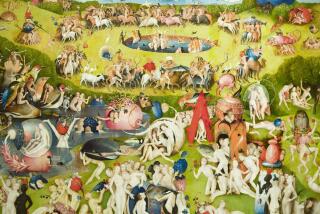‘Jeff in Venice, Death in Varanasi’ by Geoff Dyer
Jeff in Venice,
Death in Varanasi
A Novel
Geoff Dyer
Pantheon: 296 pp., $24
Why do education and cynicism so often go hand in hand? Heaven forbid an intellectual should be wholehearted or, God help us, earnest about anything. Geoff Dyer is an intellectual, and not just because of the Oxford education -- because his books, fiction and nonfiction, are all in pursuit of something, some idea. He builds on the work of other writers, among them, John Berger, Somerset Maugham and D.H. Lawrence. His books build on literature. He’s in the business of making a higher wall to peer over into the neighbor’s garden.
That said, cynicism is Dyer’s downfall, and he has been in a free-fall to the acid pits since his marvelous, wondrous book about grappling with Lawrence, “Out of Sheer Rage.” The old Dyer dived into his work (just look at “But Beautiful,” his book about jazz). Something happened. Interviews with Dyer are thickets of irony; essays on travel are sometimes beautiful and discursive but are often pratfalls from a great height -- the effort to write like W.G. Sebald (who was rarely cynical). The books are patched together from autobiographical experiences and freelance articles. Every so often, one gets a glimpse of a real quest, profound malaise, all too quickly smothered by manic cleverness.
Because we are in it for the long haul (and Dyer’s fans are legion), we are going to take this strange new book, “Jeff in Venice, Death in Varanasi,” as the pivot, the point at which the author gets back to work. There is, in other words, nowhere to go but up!
The book is divided into two seemingly unrelated parts. In the first part, freelance writer Jeff Atman has been sent by a magazine, Kulchur, to cover the Venice Biennale. Wow, is he smarmy. He hates writing, he hates the meaningless articles he’s been writing, he hates his editor. His favorite word is “bollocks.” He goes to a bunch of parties and meets a woman from the U.S., and they hook up after some witty banter. “ ‘Ah, bollocks,’ she laughed. ‘The very essence of the English.’ ‘You’re right,’ ” he says. “ ‘You have freedom and the pursuit of happiness. We have . . . bollocks to it.’ ” There are many references, Dyer-style, to artists, popular culture and writers -- “The Truman Show” (kind of ominous), Gilbert and George, Ed Ruscha, the photographs of Salgado and more, but they are half-hearted place-holders, status bits, none of the old grappling. All that education looks like accessorizing.
In Part 2, a freelance writer is sent to Varanasi, India, to write a 1,200-word travel piece. He watches the cremations by the Ganges, writes the story and checks into a new hotel. He hunkers down as the revelations come hurtling at him, thick and fast -- freeing himself of desire, losing himself in “the infinitude of something.” It would be easy to get cynical at this point, but after the pointless existence of Jeff Atman in Part 1, there’s nowhere to go but up! Sure enough, he shaves his head and dons a dhoti. “I am in mourning for myself,” he tells a friend. “My old self refuses to die. The new is struggling to be reborn. In this interregnum a great variety of morbid symptoms appear.”
My sentiments exactly. “The essence of Lawrence’s life and writing is away from the notion of achieving some permanent state of unruffled serenity,” Dyer wrote in “Out of Sheer Rage.” “Never content simply to record his transitory feelings and surges of emotion, Lawrence was always wanting to turn them into some permanent testimony, into a ‘philosophy’ -- and no writer was temperamentally less suited to do so. Lawrence is at his best when he is recording his fleeting moods and impressions without trying to fit them into any kind of design, even the artistic one of a novel.”
This is also true of Dyer, I think, but forgive me my earnestness. I hear a cry in this book that wells up between the two halves. (We could do Dyer a favor and refer to these halves as Atman/Brahmin; even the most cynical freelance writer has the potential for rebirth, but that would be way too generous.)
Dyer dodges the autobiographical nature of this broken book with a flotilla of explanatory notes identifying quotes and other references, but in these days of the shell-game author (nonfiction-fiction-hybrid), a reader has to assert his or her instincts now and then.
We’ll pass over this little blip, this little burp. History will smile fondly on this midpoint in Geoff Dyer’s great oeuvre.
Now, back in the saddle; cowboy up!
More to Read
The biggest entertainment stories
Get our big stories about Hollywood, film, television, music, arts, culture and more right in your inbox as soon as they publish.
You may occasionally receive promotional content from the Los Angeles Times.










